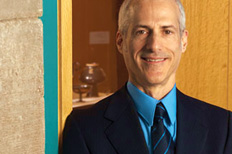Bowdoin College's visionary commitment to the arts is perhaps best exemplified by an extraordinary event that it sponsored in 1927.
From May 2 to May 13 of that year, the College was home to an Institute of Art that featured a host of public lectures by visiting scholars, as well as a series of undergraduate roundtables. The institute was nothing if not ambitious in its objectives. Its program began with a lecture called “Why We Study the Fine Arts,” and progressed to encompass such topics as pre-historic art, architecture, prints, and, most notably, modern art. One of the members of the organizing committee, stressing the incubational nature of the institute, declared that it was open to members of the greater local community since “the idea of the committee had been to make the adventure a communal rather than a collegiate privilege.”
The Institute of Art introduced the Bowdoin and Brunswick communities to two of the most influential proponents of modern art in America, Walter Pach and Alfred H. Barr, Jr. An artist and a critic, Pach had been one of the organizers of the 1913 International Exhibition of Modern Art, known as the Armory Show. Barr, who was then teaching at Wellesley College, would become the first director of the Museum of Modern Art in New York in 1929, and had already gained a reputation as “one of the foremost of the younger interpreters of modern tendencies in Art,” according to the institute's program. Indeed, it was the topic addressed by the “very modern” Mr. Barr that engendered the most interest. “They [the students] are ‘laying for’ Professor Barr of Wellesley and if he goes away without having taught some culture-thirsty undergraduates just how to appreciate the art contributions in The Dial there is many a lad—and one professor's wife—who will be profoundly disappointed.”
Barr's lecture at Bowdoin was one of a series of talks central to the crystallization of his thinking about modern art. In the course of his lecture, Barr emphasized the degree to which “progressive” American artists since 1900 had adapted aspects of European tradition to their own needs: “In fact, their sources are, in the main, European although frequently American painters have transformed them into an art which seems to some extent indigenous.”
Bowdoin's Institute of Art was met, locally and nationally, with an overwhelmingly positive response. Kenneth C. M. Sills, then president of the College, reflected on the event during his closing remarks: “Feeling that art would not be so popular a theme as either Modern History or Modern Literature, we thought we might be doing a service to Art by this Institute; and we find that Art has done much for us.” The remarkable nature of these events was not lost on members of the press, as one journalist noted: “As far as this writer could learn, this is the first time that such an institute or series of conferences has ever been attempted, at least by a New England College.”
It is very much in the spirit of the 1927 Institute of Art that the Bowdoin College Museum of Art signed on as a partner in one of the pilot projects of the Yale University Art Gallery’s collection-sharing initiative. Funded by the Andrew W. Mellon Foundation, the initiative supports Yale’s pioneering efforts to share their exceptional art collection and resources with six other colleges in the region. Participation in this remarkable endeavor has allowed us to address one of the more serious lacunae at the Bowdoin College Museum of Art—American modernism.
Inclusion in the Yale University Art Gallery’s collection-sharing initiative has also allowed us to pioneer new and interdisciplinary models of object-based learning in areas that our collections could not otherwise support, to re-contextualize the museum’s permanent collection, and to advance student and faculty scholarship. The faculty-student-public synergy that the initiative makes possible at Bowdoin could only take place at a college or university museum, where experimentation is the norm. As a reporter for the Boston Transcript wrote of the 1927 Institute of Art at Bowdoin, “This in itself is significant of what one small college is doing to keep up the heritage of imparting culture as well as knowledge—something often forgotten in this age of machinery and Big Business. It is something that Bowdoin should get a great deal of credit for. ”
